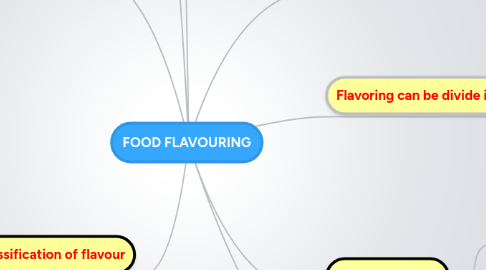
1. Classification of flavour
1.1. Fruit
1.1.1. Citrus
1.1.2. Non Citrus
1.2. Vegetable
1.2.1. Fresh
1.2.2. Dried
1.3. Spice
1.3.1. Aromatic
1.3.2. Lachrymatory
1.3.3. Hot
1.4. Beverage
1.4.1. Unfermented
1.4.2. Fermented
1.4.3. Compounded
1.5. Meat
1.5.1. Mammal
1.5.2. Fish
1.5.3. Fowl
1.6. Fat
1.6.1. Vegetable
1.6.2. Animal
1.7. Cooked
1.7.1. Broth
1.7.2. Vegetable
1.7.3. Fruit
1.8. Empyreumatic
1.8.1. Smoky
1.8.2. Boiled
1.8.3. Fried
1.8.4. Roasted
1.9. Strench
1.9.1. Fermented
1.9.2. Oxidized
2. Flavor Enhancer
2.1. A compound with no intrinsic flavorof its own but with the ability to enhance the perception of flavor
2.1.1. Yeast Extracts
2.1.2. Nucleotides
2.1.3. Hydrolyzed Plant and Vegetable Protein
2.1.4. Maltols and ethyl maltol
3. Technical Problem with flavor
3.1. Stability of concentrate/solution
3.2. Flavor quality
3.3. Packaging
3.4. Authenication/labeling/legality
4. Reason used in food
4.1. To impart characterictics flavor of the flavoring
4.2. To augment , complement or modify of a flavor
4.3. To mask the original flavor
4.4. To compensate for the flavor dissipited during processing
4.5. economic factors may retrict the use of natural material
4.6. The form of the natural material may not permit it to be used in the finished products
5. Is a property of a food or beverage that cause the simultaneous reaction of tongue and odour in the olfactory centre of nose
6. Delivery System
6.1. Solution
6.2. Solids
6.3. Emulsion
6.4. Neat
7. Flavoring can be divide into three category
7.1. Nature-identical flavoring
7.1.1. Natural identical flavoring subtances ---Obtained by synthesis or isolated through chemical processes from a natural aromatic material and are identical to a subtance present in natural products
7.2. Artificial Flavoring
7.2.1. From artifiicial flavoring subtances ----chemically synthesised , not found exist in nature
7.3. Natural Flavouring
7.3.1. From natural flavouring subtances ---Can be obtained naturally occuring plant material .Example herb and spices
7.3.2. Disadvantage
7.3.2.1. High cost
7.3.2.2. Low intensity and impact
7.3.2.3. Flavor variation
7.3.2.4. Flavor profile
7.3.3. Natural Sources
7.3.3.1. Vanilla
7.3.3.2. Aromatic Vegetable
7.3.3.3. Juices and Concentrated
7.3.3.4. Herbs and Spices
7.3.3.4.1. Contain high level in seasoning blend
7.3.3.5. Reaction /Process Flavor
7.3.3.5.1. Can be obtained through two main reaction
7.3.3.6. Can be obtained through
7.3.3.6.1. Distillation
7.3.3.6.2. Concentration
7.3.3.6.3. Biotechnology
7.3.3.6.4. Extraction
8. Example Herbs and spices
8.1. Oleoresin
8.1.1. The extractive which contain non-volatile oils , depending on the product.They are extracted by solvents which are later removed
8.1.2. Advantage over conventional spices
8.1.2.1. Free from physical impurities
8.1.2.2. Concentrated form, reduces storage space and bulk handling and transport requirement
8.1.2.3. Free from pathogens and microbiological contaminants
8.1.2.4. Standadized product
8.1.2.5. Flexibility to develop multiple spice blends if required
8.1.2.6. Uniform dispersion of spice extract provides instant flavour release
8.1.2.7. Concentrated extract can be diluted to varying strength to meet required end used flavor , taste, color
